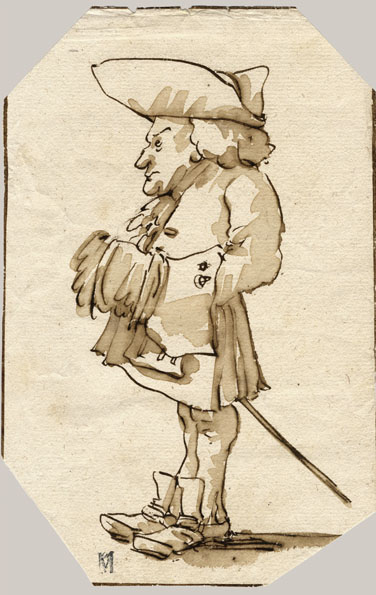(Venice 1696 - Madrid 1770)
CARICATURE OF A MAN WEARING A TRICORN STANDING IN PROFILE TOWARD LEFT
Pen and brown ink, brown wash, the four corners cut; 203 x 194 mm.
PROVENANCE: Possibly the conti Valmarana Vicenza; Giovanni Morelli, 1816-1891 (Lugt 1902)
Several other caricatures by Giambattista Tiepolo, also with the corners cut and often with pen and ink framing lines, were in the collection of the art historian Giovanni Morelli. Eight of these are now in the Castello Sforzesco, Milan. They were formerly in the collection of Gustavo Frizzoni, who inherited some of Morelli's collection of drawings. See G. Bora, I disegni della Collezione Morelli, Milan, 1988, nos. 89-92 reproduced.
Giambattista Tiepolo’s caricatures have generally been dated to his last Venetian period, following his return from Würzburg in 1753, and before his departure for Spain in 1762. It is thought that caricatures by Giambattista and Domenico Tiepolo once made up at least three albums. Two of these albums, containing ‘an ample collection of humorous drawings by Tiepolo’, are recorded in the collection of Count Bernardino Corniani degli Algarotti in Venice in 1754. A further album of 106 drawings, entitled 'Tomo terzo di caricature' and also possibly from the Algarotti-Corniani collection, was acquired by the bookseller John Grant in Edinburgh in 1925 and sold by him to the collector Arthur Kay; that album seems to have remained intact until it was broken up and sold at auction in London in 1943. Assuming that there was a Tomo primo and a Tomo secondo, and a roughly equal number of drawings in all three albums, it may be determined that there must have been some three hundred of these caricatures. Around two hundred examples survive today, most of which are by Giambattista Tiepolo. The present sheet may be presumed to have originated in the collection of the Conti Valmarana of Vicenza, which seems to have included a large number of Tiepolo caricatures. The drawings associated with the Valmarana collection are, for the most part, depictions of single figures, with most seen from the back. Almost all have cut corners, which suggests that they were once pasted into the albums.
Born into a wealthy family in Venice, Giambattista Tiepolo was recognized by contemporaries throughout Europe as the greatest painter of large-scale decorative frescoes in the 1700s. He was admired for having brought fresco painting to new heights of technical virtuosity, illumination, and dramatic effect. In 1710 Tiepolo became a pupil of Gregorio Lazzarini, a successful painter with an eclectic style. He was, though, at least equally strongly influenced by his study of the works of other contemporary artists such as Sebastiano Ricci and Piazzetta and those of his Venetian predecessors, especially Tintoretto and Veronese. In 1719 he joined the Venetian guild of painters and soon turned away from the darker hues of the Baroque opting for sunny colorful tableaux instead. His first success testified to his new style: a series of frescoes on biblical scenes for the episcopal palace in Udine in 1726.Tiepolo's commissions came from the old established families of Italy, religious orders, and the royal houses of Spain, Germany, Sweden, and Russia. Tiepolo was equally prized as a draftsman: his powers of invention were boundless and his facility without equal. His imaginative prints enjoyed wide fame and their dreamlike and sometimes troubling imagery of sorcerers and punchinellos may have influenced Goya.
